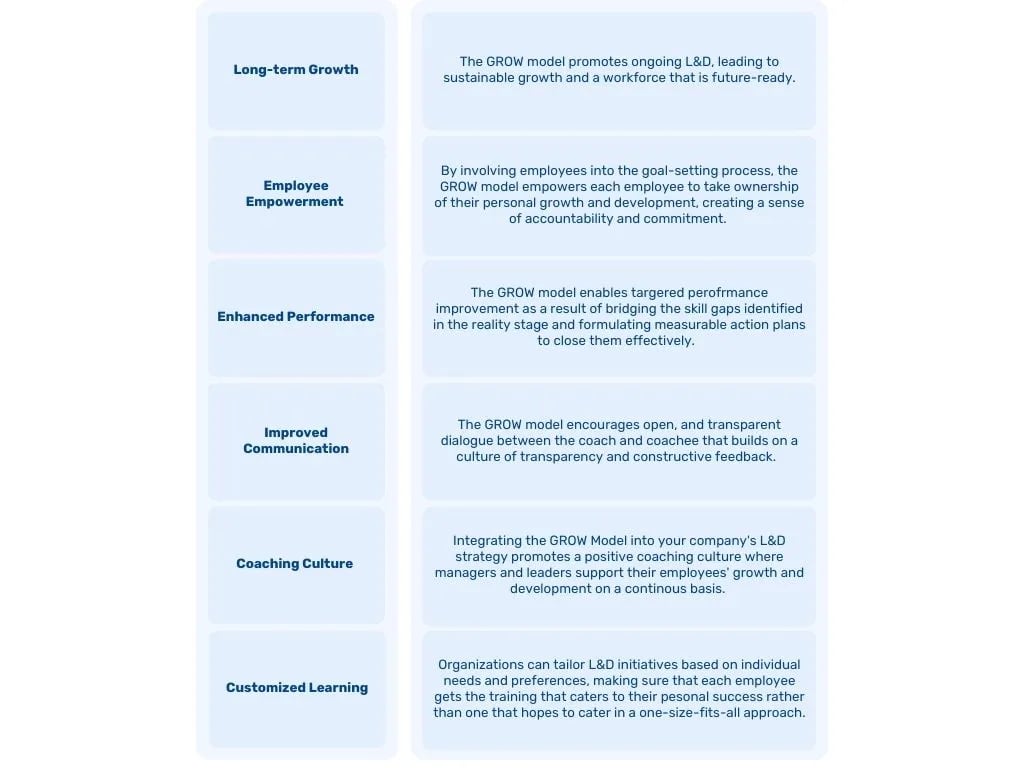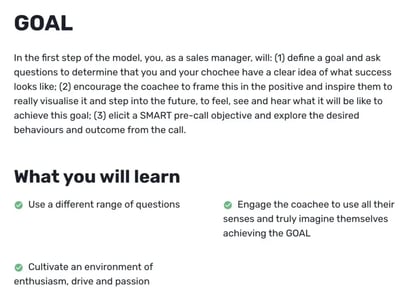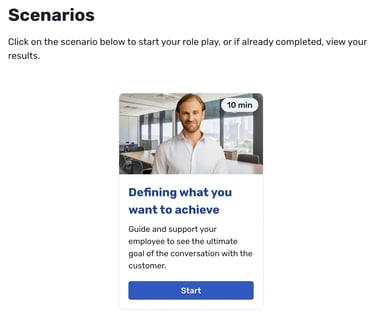Despite 83% of organizations believing that developing their leaders into even better leaders is important at every level of the company, only 5% of businesses have implemented any leadership development at all levels.
If you believe it too, it's time to finally act upon it.
Organizations these days are driven by a relentless pursuit of growth and success. As companies navigate competitive markets and disruptive challenges, they must invest in their most valuable asset: their employees.
Learning and Development (L&D) has emerged as the bedrock of nurturing talent, driving productivity, and building incredible innovation.
When looking at leadership statistics in this past year, it is clear that leadership plays a huge role in the success of a business. Thus, enter the GROW model - a transformative coaching framework that is taking the world of L&D by storm.
This blog post will delve into the heart of L&D excellence - exploring five ways to leverage the GROW model for unparalleled success. You will soon discover how to invigorate your workforce, cultivate a growth mindset, and properly your organization to new heights of mighty achievement.
So... whether you are a visionary leader, an ambitious professional, or an L&D enthusiast, you can now begin to learn how to master the GROW model to shape a brighter future for businesses, employees, and stakeholders alike.
Get ready to unlock the doors to lasting success - the GROW way.
What's in this post?

What is the GROW model?
According to Performance Consultants International, the GROW leadership model is a coaching framework utilized in meetings, conversations, and daily leadership to open up possibilities within an organization. It was founded by Sir John Whitmore in the late 1980s along with Graham Alexander and Alan Fine. Since then, the model has grown to be the most widely used coaching model in the world for problem-solving, goal-setting, and performance enhancement among managers, executives, and several industry leaders including Google.
The "Inner game" method was developed by tennis coach Timothy Gallwey which served as the basis for the GROW coaching model. Gallwey came to the realization that, although he understood his player's issues, he could not persuade them to correct their flaws by merely explaining them.
You can see the parallel between the GROW model and Gallwey's strategy like this: When asking tennis players to keep their eyes on the ball, it can become a challenge in the long run, and only achievable for a short while. Therefore, Gallwey decided to ask his players to say "bounce" out loud when the ball bounced and say "hit" out loud when they hit the ball. This resulted in players being able to maintain their focus on the ball as a result,w which let them perform better with little effort.
The GROW model and Gallwey's method both use awareness-raising questions to guide individuals toward problem-solving by helping them recognize what they may or not may not be doing incorrectly. The claim made here is that a lot of people are incapable of drawing lessons from their past mistakes and utilizing their available knowledge to advance to moving forward.
What does GROW stand for?
GROW model involves four main stages: Goal, Reality, Options (or Obstacles), and Way Forward. Each element represents a key step in the coaching process, guiding both the coaches and individual learners toward creating actionable plans and strategies for success.
Grow
The first step in this GROW model involves establishing a clear and specific goal on what the employee wants to achieve in the long term. Whether those goals are personal goals or professional goals. These goals can include, for example, developing specific leadership skills to improve team performance, or enhancing communication skills.
In this stage two objectives should be set: one for the training session (what is the aim of this session?), and another long-term objective (What is the larger goal/obstacle they want to address and overcome?).
This stage is simply about focusing on what they wish to achieve for their own personal development. You can also implement the SMART system to help employees set their goals, where their goals should be Specific, Measurable, Achievable, Realistic, and Timely.
Reality
In this reality stage, the objective is to assess the current reality and identify any areas of improvement needed. This is also a self-reflection stage and feedback from peers or a team member who may have an insight into what you can improve on or where your strengths are.
You can also identify your own strengths and weaknesses, as well as potential blind spots that will help you to gain awareness of your current leadership or management style, and where you can develop on.
What is your current situation, and what do you not like about it or want to change? This is an important stage because it also includes examining any potential obstacles, challenges, or limiting beliefs that may hinder progress toward the goal.
Essentially, this step helps employees to gain a realistic understanding of their starting point and potential roadblocks.
Options
In this options stage, once the employees have identified what their current reality is, and completed their goal setting, employees can begin exploring the different strategies to bridge the gap between the current reality and the desired goals.
What can they do to stay focused on their goals, and enter their new reality? What are the different options for development that are available? This stage involves brainstorming different approaches and learning methods that align with the employee's learning style and preferences to see what works best for them at their desired pace.
Companies can present a range of learning resources such as workshops, training programs, Online learning modules, mentorship, job rotations, or external courses.
Encouraging employees to take ownership of their learning journey will empower them to choose the most suitable path for their development.
Way Forward
This final step of the GROW model revolves around crafting a concrete action plan to bridge the gap between their current reality and the desired learning outcomes.
Employees, with the guidance of L&D professionals, can establish a step-by-step plan outlining the specific learning activities, timelines, and progress markers to track progress on their performances and growth. This action plan also serves to ensure accountability throughout their learning process.
Regular feedback and support from the training program or company are also crucial in maintaining motivation and making necessary adjustments to the path as the learner progresses.
It is also important to remember that when an employee has set a clear action plan, their buy-in and commitment increase!
Why is the GROW model important?
The GROW model is a goal-setting model that holds paramount importance in the business world. Its significance lies in its ability to empower individuals and teams, build a growth-oriented mindset, and drive tangible results in various business settings.
The simplicity and adaptability of the GROW model for coaching in the workplace are highly valued by leaders and coaches. They observe the effects in their regular encounters with others.
To engage employees, encourage outstanding performance, and increase productivity, organizations integrate GROW into their management procedures and leadership models. Because of this, some of the most prosperous businesses in the world, including Google, train their managers on how to utilize GROW.
GROW coaching abilities unlock potential and boost output by boosting self-assurance and inspiration. Effective questions that are thoughtfully crafted encourage increased accountability and deeper awareness, which leads to actionable activities to reach objectives and solve challenges.
Higher productivity, greater communication, stronger interpersonal ties, and a higher-quality working environment have all been seen to result from the GROW Model.
Here are two key reasons why the GROW model is important:
-
Employee engagement and retention: Employees that are engaged in their work are more likely to be devoted to their organization. Businesses can create an atmosphere that emphasizes employee development and well-being by incorporating the GROW model into talent development programs. Employees feel supported and appreciated, which as a result, raises work satisfaction and lowers turnover.
-
Leadership development: Strong leadership is essential to the success of any organization. The GROW model is important for leadership development programs because it assists aspiring leaders in setting important objectives, evaluating their present abilities, and creating plans of action to acquire the essential competencies.

Overall, the GROW model also helps leaders and managers to become better versions of themselves, and learn how to communicate in a way that is positive, affirming, constructive, and motivating.
Each coaching session that implements the GROW coaching model is a step forward in strengthening the manager-employee relationship. Managers can utilize this model to guide their team members' development, providing regular feedback and support. This coaching culture promotes continuous learning and builds a positive work environment.
How is the GROW model used to train managers?
The GROW model aids in the development of essential coaching and leadership skills. When used for manager training, the GROW model focuses on equipping managers with the tools to support their team member's growth, improve performance, and create a positive and productive work environment. Here is how the GROW mode is used to train managers:
-
Coaching skills development: Manager training with the GROW model emphasizes coaching skills, teaching managers how to effectively guide and support their team member's development. They acquire the skills of active listening, asking powerful questions, and providing constructive criticism. By adopting a coaching approach, managers can empower their team members to take ownership of their growth and development.
-
Goal-setting and Alignment: Using the GROW model, managers are taught to define precise, quantifiable goals with their teams. They learn to align individual goals with the organization's objectives, ensuring that each team member's effort contributes to overall success.
-
Performance improvement: The GROW model is used to help managers address performance issues within their teams. By guiding team members through the GROW stages, managers can identify performance gaps, explore potential solutions, and create action plans for improvement.
-
Talent Development and Succession Planning: Through this model, managers learn to identify high-potential employees and support their career development.
5 ways to use the GROW coaching model
The GROW coaching model should be used whenever your company feels like they want to develop its L&D journey. Implementing the GROW model helps to reduce retention rates, increase employee engagement, and have more successful learning outcomes and learning journeys, career development, performance improvement, and for overall personal and professional development.
-
Goal-setting workshops: Conduct interactive goal-setting workshops using the GROW coaching model to help employees set SMART learning objectives. Encourage employees to define the specific goals aligned with their roles, career aspirations, and the organization's strategic priorities.
-
Performance improvement coaching: companies can implement the GROW coaching model to address any performance gaps and enhance employee skills. Managers and L&D facilitators can use the model to assess current performance levels, explore potential obstacles, and identify suitable development options to prove L&D training.
-
Group coaching session: Companies should also consider using the GROW model in a group setting when they aim to facilitate collaborative learning, create a growth mindset, and optimize the development of multiple individuals simultaneously. The GROW model's framework makes it also suitable for group learning and development scenarios such as workshops, team-building sessions, or leadership training programs. Not only does group coaching build on team alignment, but it also fosters collective problem-solving skills, that provide a space for employees to brainstorm creative solutions together and increase mutual support and accountability.
-
Leadership development programs: Integrate the GROW model into leadership development initiatives. Equip all leaders and managers with coaching skills, guiding them to support their team member's growth in a healthy and positive way. This approach guarantees a strong culture of positive leadership development, enhancing employee engagement, and promoting a coaching-oriented leadership style within the organization where all employees feel heard and safe.
-
Career development coaching: The GROW model can help conduct one-to-one career development coaching sessions. Employees can explore potential career paths, identify skill development opportunities, and strategize their professional and personal growth. These coaching session help align individual aspirations with the organization's talent needs, resulting in a more motivated and committed workforce.
Benefits of using the GROW coaching model
The GROW coaching model inevitably builds on healthy coaching cultures that foster positive development within an organization.
💡 So what are the benefits? There are just sometimes too many! but we have narrowed it down to a few key points

How can you conduct a GROW model training?
There are a number of coaching models that are available to help train all managers into bringing out the best leader within themselves.
Coaching models usually contain coaching questions that allow the coaching conversation to be productive, and effective - allowing for self-reflection to flow naturally and getting the coachee to think about what they desire to change.
Below are easy steps you can follow to conduct a GROW model training:
-
Clearly define the objectives of the GROW model training. Determine where the focus will be on. Leadership development, performance improvement, improving communication skills? Coaches should communicate to their coachee what it is that they will focus on, and can do so by asking questions that not only visualizes success but also being SMART about the goals desired to be achieved
-
After asking questions to help the coachee think about their reality for themselves, the coach can then help the coachee see different perspectives and provide fair and balanced feedback on points that the coachee missed out on.
-
The coach can now encourage ideas and guide the coachee into what they can do to start working towards their goal. The coach helps the coachee to move forward with their plan and see what resources and materials are available.
-
The coachee now takes full responsibility for their action plan and can move towards achieving their desired reality. The coachee knows what needs to be done and what comes first. The coach will then ask the coachee for any feedback that can help the coach with their own self-improvement.
Retorio's GROW coaching model helps employees in achieving goals that will unlock their own potential and propel them to reach their career goals effectively and efficiently.
Retorio's coaching model implements the GROW strategy to train managers to excel in any given real-life scenario that requires productive communication. With the scenarios in our training, managers are presented with four types of behavior scores: Basic Behaviors, Developing Behaviors, Proficient Behaviors, and Mastery Behaviors.
As managers continue their training and learn from their feedback, they can eventually progress to Proficient and Mastery behaviors.
The new skills that managers gain from this training, therefore, prepare them to handle any situation at a Mastery Behavior level. Furthermore, it also encourages employees to cultivate a coaching mindset of their own.
Retorio uses the GROW coaching model to also make sure that leaders and managers help employees to stay SMART about their goals. This also helps to keep managers on the right track and make sure that the conversation between them at the coachee targets each step of the GROW model where the goal of the conversation is clearly established, the reality of the situation is assessed, the options of what can be done to achieve the goals are clear, and what the first step in moving forward is.


Retorio's AI-powered coaching platform focuses on the communication language style as well as screening facial expressions, speaking speed, phrase complexity, and much more. The more in-depth the analysis is, the better quality of feedback received that is tailored exactly to every individual's learning style and path.
Each training provides managers with guidance on what they can say to achieve Proficient Behavior to Mastery Behavior results without giving it away. However, there is always room for feedback, and this feedback is delivered to each manager on a silver platter - personalized, encouraging, and constructive.
Each feedback round is clear and concise as to what each manager can improve on, what they can mention in their next response, and what it is that they did well.
Retorio's AI-powered training platform could not have made your L&D training go any easier or more efficient. By implementing the GROW model and SMART goals to ensure that each coaching session runs successfully, every organization can now easily jump-start their journey into enhancing employee performance, and employee engagement and seeing numbers fly skyrocket when you begin to attract top talent and improve employee retention!
It's as easy as clicking the button below!
FAQ
A coaching model is used to assist salespeople in moving from where they are now to where they want to be or achieve in the future.
Overall, coaching directs the dialogue by concentrating on the future development and accomplishment of salespeople. As a result, sales coaching models place a strong emphasis on the long-term bond between coach and coachee. However, coaching talks or sessions are often brief and aimed at a single objective.
GROW coaching abilities unlock potential and boost output by boosting self-assurance and inspiration. Effective questions that are thoughtfully crafted encourage increased accountability and deeper awareness, which leads to actionable activities to reach objectives and solve challenges.



